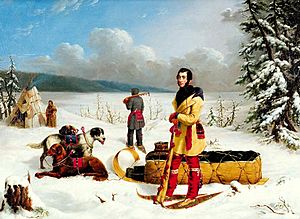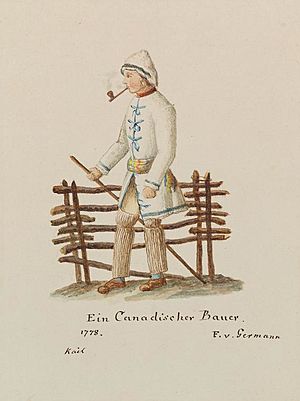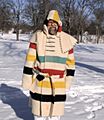Capote (garment) facts for kids

A capote (say "kah-POT") is a long, warm coat made of wool, usually with a hood. It wraps around the body to keep you warm.
For hundreds of years, people in North America wore capotes to survive the cold winters. Both Indigenous peoples and early European Canadian settlers made these coats from wool blankets. They were popular winter clothes for First Nations, the habitants (French farmers), and voyageurs (fur traders) of New France. Later, the Métis people, British settlers, and trappers also wore them.
The Hudson's Bay Company (HBC) sold special capotes called blanket coats. These were made from the company's famous "point" blankets. They became popular in the early 1700s at HBC trading posts. Traders liked their wrap-around style because it was easy to move and hunt in. These Hudson's Bay blanket coats even inspired the design of the Canadian Mackinaw jacket. The word capote came into the English language from French around 1812.
Contents
Habitant Capote: A Unique French-Canadian Coat
In the early 1600s, French sailors traded their capotes with the Mi'kmaq people in North America. By 1619, French settlers, known as habitants, also started wearing them. About 50 years later, the habitants changed the capote's design. It might have been inspired by the fashionable justacorps coat or the uniforms of French soldiers in New France.
This new knee-length version had no buttons. Instead, it was worn with a military sash, called a Ceinture fléchée. This habitant capote was different from both the sailors' and soldiers' coats. It combined features from both to create a unique winter jacket. In Quebec French, this special coat is called a capot. The word encapoter or s'encapoter also came from this, meaning to put on a capot and other winter clothes before going outside.
Métis Capote: Style and Function

The Métis people also wore capotes, especially for winter. These coats were usually thigh-length with long sleeves. Some had hoods or capes. Many Métis capotes had small decorations on the shoulders, often made of "red stroud." This "red stroud" was a special red cloth used for British Army uniforms.
Métis capotes from the Red River area were made from either leather or wool. Leather capotes were often decorated with colorful beads and silk embroidery, often showing floral designs. Wool capotes came in different colors. Blue was popular with Catholic Métis, and white was preferred by Protestant Métis. Grey capotes were worn by both groups.
A sash was worn around the waist of the capote. People often tucked a "fire bag" into the sash or wore it around their neck. A fire bag held things needed to start a fire, like flints and steel. It also carried tobacco, a pipe, a knife, and other personal items, since most capotes didn't have pockets.
In 1823, William H. Keating described a group of Métis buffalo hunters near the Red River. He said they all wore blue capotes with hoods, which they used in bad weather. Their capotes were held closed by a military sash.
Capotes in Canadian Culture
In the late 1800s, the blanket coat became very popular among European Canadians. It was even seen as a kind of national dress. People who worked outdoors had used blanket coats for a long time. But during this period, the coats started to follow European and American fashion trends. This made them even more widely used.
The popularity of the capote was part of a bigger movement. Canadians wanted to create their own identity, separate from both Britain and the United States. They did this by adopting parts of Indigenous culture. Two important groups helped make the blanket coat famous:
- The Montreal Snow Shoe Club: This club made the blanket coat a required part of their uniform. Snowshoeing was another activity adopted from Indigenous peoples, and it became a very popular sport.
- Governors General of Canada: Several Governors General were photographed wearing blanket coats. Even more important for spreading the fashion were their wives, known as viceregal consorts. At first, the capote was mostly a men's garment. But by this time, versions were being made for women and children too.
Gallery
-
William Jackson (Little Blackfeet) on a white horse, Siksika (Blackfoot), Montana. About 1900s.
-
A traditional capote made with a Hudson's Bay point blanket.










